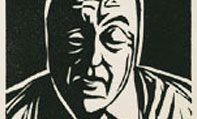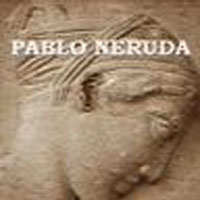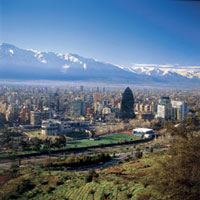- About Us
- Columns
- Letters
- Cartoons
- The Udder Limits
- Archives
- Ezy Reading Archive
- 2024 Cud Archives
- 2023 Cud Archives
- 2022 Cud Archives
- 2021 Cud Archives
- 2020 Cud Archives
- 2015-2019
- 2010-2014
- 2004-2009
 |
Pablo Neruda and the poetry of South American love. |

On 12 July 1904 Neftalí Ricardo Reyes Basoalto, was inconspicuously born in the small Chilean town of Parral, the son of a railway working father and teaching mother who died shortly after his birth. On 23 September 1973, Neftali – by then known as Pablo Neruda the Nobel Laureate and South America’s greatest poet, died of leukaemia in the Chilean capital Santiago, shortly after the murder of President Salvador Allende.
It was Allende’s socialist government that had appointed Neruda as Chile’s Ambassador to France from 1970-72, yet it has been suggested that the politics of Chile hastened the death of the despairing socialist poet – his decline accelerated by the murder of Allende and the Pinochet coup in 1973. Modern day Chile’s imminent return to a left wing government however, with the recent success of Michelle Bachelet, may have restored something his own personal vision of Chile (Bachelet, a 54-year-old socialist pediatrician was elected in January and takes office on 11 March). In the midst of these months of significant South American political events sits the unrelated commercial spectacle of Valentine’s Day, which of itself should have precious little to do with the government of Chile. Yet, however tenuous the link, thoughts of romance (on 14 February or any other time of the year) will inevitably lead me back to Neruda’s Chile and the poetry of South American love. For at the age of only 20, Neruda (the pen name which he adopted in memory of the Czechoslovak poet Jan Neruda (1834-1891) and used for over 20 years - before adopting it legally in 1946) wrote Veinte poemas de amor y una cancion desesperada (Twenty Love Songs and a Song of Despair) in Santiago. Correspondingly at the age of 28, I met and fell briefly in love with a Chilean woman in Santiago, and mere days later was introduced to Neruda’s first of many collections of love poetry. The episodic romance of that particular woman has passed. The romance of the poetry and the country that she reminds me of has not.
 On 14 March last year, I traveled to the World-Heritage-Listed Chilean coastal town of Valparaiso. Some days earlier I had met a beautiful Santiago local in a wonderfully sensual bar - Clandestinos. The few hours west from the Chilean capital to Chile’s oldest port and historical stop over, en route around the Horn, I had left behind a lover in Santiago for a few days, but found Neruda’s majestic coastal residence - La Sebastiana. Knowing nothing of Neruda until the recommendation of a ‘quiet American’ the night before, I was immediately captivated by the eclectic assortment of maps, poetry and views of the Western Pacific. His own words were chiseled into a wall in one place:
On 14 March last year, I traveled to the World-Heritage-Listed Chilean coastal town of Valparaiso. Some days earlier I had met a beautiful Santiago local in a wonderfully sensual bar - Clandestinos. The few hours west from the Chilean capital to Chile’s oldest port and historical stop over, en route around the Horn, I had left behind a lover in Santiago for a few days, but found Neruda’s majestic coastal residence - La Sebastiana. Knowing nothing of Neruda until the recommendation of a ‘quiet American’ the night before, I was immediately captivated by the eclectic assortment of maps, poetry and views of the Western Pacific. His own words were chiseled into a wall in one place:
“I built the house. I made it first out of air. Later I raised its flag into the air and left it draped from the firmament, from the stars, from clear light and darkness.”
Aside from the 21 poems already mentioned, there were various translated collections – not least Odes to Common Things, where tables, chairs, guitars and other inanimate objects are brought to life, even in their English translation. I wondered whether such poetry comes best from simple things. Is love so simple as in Oda al Vino (Ode to Wine)?
“Amor mio, de pronto
tu cadera
es la curva colmada
de la copa,
tu pecho es el racimo
la luz del alcohol tu caballera,
las uvas tus pezones,
tu ombligo sello puro
estampado en tu vientre de vasija,
y tu amor la cascada
de vino inextinguible,
la claridad que cae en mis sentidos,
el splendor terreste de la vida.”“My love, suddenly
your hip
is the curve of the wineglass
filled to the brim,
your breast is the cluster,
your hair the light of alcohol,
your nipples, the grapes
your navel pure seal
stamped on your barrel of a belly,
and your love the cascade
of unquenchable wine,
the brightness that falls on my senses,
the earthen splendour of life.”
 Certainly his study in Valparaiso, with its wine glasses, a view of his beloved sea and city spawned beauty on the page. Three of Neruda’s houses are now maintained in Chile -, La Sebastiana in Valparaiso, a permanent home on Isla Negra - off the coast, and La Chacona in Santiago. So I returned to the Latino emotion of a young woman in Santiago, where she offered me her city and her nation’s poet as much as she offered herself. In return, my offerings seemed to be unsuccessful: flowers - an inelegant handpicked collection from the local park in the absence of any florist that I could find in Santiago; concert tickets to the Santiago Philharmonic - which started too early for her to meet me; and a dinner invitation - only to find that the highly recommended Como Agua Para Chocolate restaurant was full, evidently ‘victim’ of a favourable entry in Lonely Planet, attested to by the hordes of tourist buses parked outside.
Certainly his study in Valparaiso, with its wine glasses, a view of his beloved sea and city spawned beauty on the page. Three of Neruda’s houses are now maintained in Chile -, La Sebastiana in Valparaiso, a permanent home on Isla Negra - off the coast, and La Chacona in Santiago. So I returned to the Latino emotion of a young woman in Santiago, where she offered me her city and her nation’s poet as much as she offered herself. In return, my offerings seemed to be unsuccessful: flowers - an inelegant handpicked collection from the local park in the absence of any florist that I could find in Santiago; concert tickets to the Santiago Philharmonic - which started too early for her to meet me; and a dinner invitation - only to find that the highly recommended Como Agua Para Chocolate restaurant was full, evidently ‘victim’ of a favourable entry in Lonely Planet, attested to by the hordes of tourist buses parked outside.
But as Neruda wrote in Plena mujer, manzana carnal (Full woman, carnal apple) from his 1960 collection Cien sonetos de amor (One hundred sonnets of love):
“Ah, love is a voyage with water and with stars, with suffocating air and brusque storms…”,
and so the night’s voyage moved inevitably forward: she’d never received flowers before, and we found ourselves at a candle lit table for many hours nestled privately in a cove of wine bottles, away from staid, impersonal concert halls and buses full of package tourists at commercialised restaurants. To say that the night was an “Ode to Common Things” would make it sound unremarkable, but perhaps the greatest romance and pleasure comes from simplicity and the unexpected - the music of a violin, born of a tree’s wood perhaps, as in another of his odes - Oda a una castana en el suelo (Ode to a chestnut on the ground):
Del follaje erizado
caiste
completa,
de madera pulida
de lucida caoba,
lista
como un violin que acaba
de nacer en la altura,
y cae
ofreciendo sus dones encerrados
su escondida dulzura
terminada en secreto
entre pajaros y hojas …Out of the bristling foliage
you fell
complete:
polished wood,
glistening mahogany,
perfect
as a violin that has just
been born in the treetops
and falls
offering the gifts locked inside it,
its hidden sweetness,
finished in secret among
birds and leaves …
 Between ages 23 and 31, Neruda traveled extensively, having received a number of honorary consulships, which saw him continually uprooted and relocated through Burma, Ceylon, Java, Singapore, Argentina and Spain. Those eight years of life remain for many the ‘ages of travel’ and despite the absence of honorary consulship, I remained driven to movement - perhaps at times losing love as a result. During this time of difficult constant movement in his twenties, Neruda compiled the collection of esoteric surrealistic poems, Residencia en la tierra (Residence in Earth) (1933), which not only marked his literary breakthrough, but also captured the lines in Arte Poetica (Ars Poetica) which described the ‘noises’ that also drew this traveler in his twenties (me) away from the romance of Santiago:
Between ages 23 and 31, Neruda traveled extensively, having received a number of honorary consulships, which saw him continually uprooted and relocated through Burma, Ceylon, Java, Singapore, Argentina and Spain. Those eight years of life remain for many the ‘ages of travel’ and despite the absence of honorary consulship, I remained driven to movement - perhaps at times losing love as a result. During this time of difficult constant movement in his twenties, Neruda compiled the collection of esoteric surrealistic poems, Residencia en la tierra (Residence in Earth) (1933), which not only marked his literary breakthrough, but also captured the lines in Arte Poetica (Ars Poetica) which described the ‘noises’ that also drew this traveler in his twenties (me) away from the romance of Santiago:
“… de pronto, el viento que azota mi pecho,
las noches de substancia infinita caidas en mi dormitorio,
el ruido de un dia que arde con sacrificio
me piden lo profetico que hay en mi, con melancolia
y un golpe de objetos que llaman sin ser respondidos
hay, y un movimiento sin tregua, y un nombre confuso.”“… suddenly, the wind lashing at my chest,
the infinitely dense nights dropped into my bedroom,
the noise of a day burning with sacrifice
demand what there is in me of the prophetic, with melancholy
and there’s a banging of objects that call without being answered,
and a restless motion, and a muddled name.”
Neruda’s absence from his beloved Chile lasted into the Spanish Civil War, during which García Lorca (whom Neruda knew) was murdered and prompted him to join the Republican movement in Spain. Appointed consul for Spanish emigration, but residing in Paris, and shortly afterwards, Consul General in Mexico, Neruda remained away from a land for which he longed. Tragically his return was filled with disappointment. Although he joined the Communist Party and was elected senator of the Republic in 1945, his protests against President González Videla's policy against striking miners in 1947 led to him living underground before fleeing in desperation in 1949.
In love, perhaps in the same way as politics, a return is not always triumphal and often leads to greater loss and sadness. As with our poet’s absence in the 1930’s and 40’s, having been released from Chile by the urge to travel, I similarly returned - unconvincing optimistic - to a woman in Santiago for Easter. Drawn uncomfortably by a slender, beautiful, ever-changing country (sometimes described as sliding off the end of the South American continent), the contradictions and uncertainties of both Chile, and my clandestine affair manifested themselves in a slender, beautiful, ever-changing woman. In hindsight, to travel into the rugged dirt roads and shear rock faces of the Andes with a Chilean woman, armed together with little more than a few clothes and my (now well worn) copy of Neruda’s poetry thrown into her 4WD, the experience was always going to be a “bumpy” ride. The return to romance was no poetic fairytale, but maintained an honest optimism, whatever the inevitable unraveling of emotion. Easter 2005 was a harsh, gratifying reality that two people were pleased to have met, to have spent the time and to look wistfully to the future, but perhaps we always expected little more than the comfort of showing the courage to spend time fruitlessly together.
Whatever the sense of separate destiny at the time, and given the fact that this dalliance is more easily described objectively twelve months later, a poem resounded for some days after leaving Santiago for the last time (or at least this part of Santiago). The poem was Puedo escribir los versos mas tristes (I can write the saddest verses) and in part reads:
“Puedo escribir los versos mas triestee esta noche.
Escribir por ejemplo: “La noche esta estrellada, y tiritan, azules, los astros, a lo lejos.”
El viento de la noche gira en el cielo y canta.
Puedo escribir los versos mas triestee esta noche.
Yo la quise, y a veces ella tambien me quiso.
…
Ya no la quiero, es cierto, pero cuanto la quise.
Mi voz buscaba el viento para tocar oido.
De otro. Sera de otro. Como antes de mis besos.
Su voz, su cuerpo claro. Sus ojos infinitos.
Ya no la quiero, es cierto, pero tal vez la quiero.
Es tan corto el amor, y es tan largo el olvido.
Porque en noches como esta la tuve entre mis brazos, mi alma no se contenta con haberla perdido.
Aunque este sea el ultimo dolor que ella me causa,
Y estos sean los ultimos versos que yo le escribo.”“I can write the saddest verses tonight.
Write, for example “The night is shattered with stars, twinkling blue, in the distance”
The night wind spins in the sky and sings.
I can write the saddest verses tonight.
I loved her, and sometimes she loved me too.
…
I no longer love her, it’s true, but how much I loved her.
My voice searched for the wind that would touch her ear.
Another’s. She will be another’s. As before my kisses.
Her voice, her bright body. Her infinite eyes.
I no longer love her, it’s true, but maybe I love her.
Love is so short, and forgetting is so long.
Because on nights like this I held her in my arms,
My soul is not at peace with having lost her.
Though this may be the final sorrow she causes me,
and these the last verses I write for her.”
My few days of hardship produced a few more pages of impassioned travel journal entries and some meager attempts to memorise a number of poems in both English and their original Spanish. Chile’s poet laureate however, evidenced his own hardships in Chile and abroad in the form of Canto General, through which ran the theme of South American nature, its people and its historical destiny. Initially it was only published as an underground work in Chile, but received official recognition in Mexico in 1950, and the approximately 250 poems were promptly translated into a dozen other languages.
But back to love.
Traveling north I met a Peruvian woman in southern Peru who spoke little English but, after I encouraged her to read the English translation of Neruda’s Cuerpo de mujer (Body of woman) … well … I fell briefly in love again. Sitting in a rooftop bar in Arequipa in the foothills of the Andes she read:
“Cuerpo de mujer, blancas colinas, muslos blancos,
te pareces al mundo en tu actitud de entrega.
Mi cuerpo de labriego salvaje te socava
Y hace saltar el hijo del fondo de la tierra.”“Body of a woman, white hills, white thighs,
you look like the world in your attitude of surrender.
My savage peasant body ploughs through you
and makes the son surge from the depths of the earth.”
for which I am much indebted to Pablo! Apparently I read the original Spanish well enough for her to feel something of the same in response.
Whether I was hardened by the previous departure, or had just read more Neruda, this time I left and didn’t return. I kept going north, yet found Neruda had affected others around the world - unsurprising in light of the vastness of his body of (woman) work. During his long literary career, Neruda produced more than forty volumes of poetry, translations, and verse drama. He remained prolific in later life, considering that at the early age of thirteen he began to contribute articles to the daily "La Mañana", among them, Entusiasmo y Perseverancia - his first publication - and his first poem. By way of example, his Obras Completas, constantly republished, comprised 459 pages in 1951; in 1962 the number of pages was 1,925, and in 1968 it amounted to 3,237, in two volumes. Even the 1994 film Il Postino (The Postman) which received five academy award nominations, tells the historical fiction of a postman who woos the most beautiful woman in his village through the assistance of Neruda, who has recently moved to the fictional island during his exile in Europe in the early 1950’s.
I’ve read countless times Neruda’s final lines of I can write the saddest verses, and perhaps these may be “the last verses I write for her” - a particular woman in Chile, but not the last verses I will write for one like her, with the help of Neruda.
Note: The translations reproduced above are taken from Essential Neruda, Selected Poems, edited by Mark Eisner, printed in 2004, bought (while greatly enamoured) in Santiago, Chile on 15 March 2005 and carried faithfully around the world ever since.
